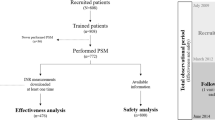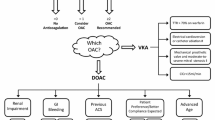Abstract
Oral anticoagulant therapy (OAT) with warfarin has become the standard therapy for the patients with mechanical heart valve prothesis. The monitoring method of self-monitoring or self-management was promising to optimize the use of warfarin, but most of previous studies have included patients with various indications of OAT, which made it difficult to extrapolate the results to the specific patient population with mechanical heart valve prostheses. This study was intended to evaluate the new and traditional monitoring methods in patients with mechanical heart valve prostheses. Relevant literature finished before Dec. 2010 were searched through a number of digital databases. And then they were pooled by RevMan 4.2 and R 2.13.0 in three fields: rate within the target range, test frequency and occurrence rate of poor events. Five randomized control trials with a total of 2,219 patients were identified. Pooled estimates showed reductions in thromboembolic events (OR 0.52, 95% CI 0.35–0.77; P = 0.0012) and all-cause mortality (OR 0.50, 95% CI 0.29–0.86; P = 0.0115). No difference was noted in major and minor haemorrhage. All trials reported improvements in the mean proportion of international normalized ratios in range. Self-monitoring and self-management can improve the quality of OAT in the patients with mechanical heart valve prostheses. The patients spend more time within the therapeutic range resulting in decreases in thromboembolic events and mortality, with no increase in haemorrhage. However, self-monitoring and self-management was not feasible for all patients, and require identification and education of suitable candidates. The success of self-monitoring and self-management method depends on consistent, regular, and frequent testing.










Similar content being viewed by others
References
Altman LK (2008) 4 winners of Lasker medical prize. New York Times. http://www.nytimes.com/2007/09/16/health/16lasker.htm. Accessed 22 Jan 2008
Yacoub MH, Takkenberg JJM (2005) Will heart valve tissue engineering change the world? Nat Clin Pract Cardiovasc Med 2(2):60–61
Bonow RO, Carabello BA, Chatterjee K, de Leon AC, Faxon DP, Freed MD et al (2008) 2008 Focused update incorporated into the ACC/AHA 2006 guidelines for the management of patients with valvular heart disease: a report of the American College of Cardiology/American Heart Association Task Force on Practice Guidelines (writing committee to revise the 1998 guidelines for the management of patients with valvular heart disease): endorsed by the Society of Cardiovascular Anesthesiologists, Society for Cardiovascular Angiography and Interventions, and Society of Thoracic Surgeons. Circulation 118(15):e523–e661
Mok CK, Boey J, Wang R, Chan TK, Cheung KL, Lee PK et al (1985) Warfarin versus dipyridamole–aspirin and pentoxifylline–aspirin for the prevention of prosthetic heart valve thromboembolism: a prospective randomised clinical trial. Circulation 72(5):1059–1063
Cobanoglu A, Fessler CL, Guvendik L, Grunkemeier G, Starr A (1988) Aortic valve replacement with the Starr-Edwards prosthesis: a comparison of the first and second decades of follow-up. Ann Thorac Surg 45(3):248–252
Bloomfield P, Wheatley DJ, Prescott RJ, Miller HC (1991) Twelve-year comparison of a Bjork-Shiley mechanical heart valve with porcine bioprostheses. N Engl J Med 324(9):573–579
O’Brien MF, Stafford EG, Gardner MA, Pohlner PG, Tesar PJ, Cochrane AD et al (1995) Allograft aortic valve replacement: long-term follow-up. Ann Thorac Surg 60(2 Suppl):S65–S70
Vongpatanasin W, Hillis LD, Lange RA (1996) Prosthetic heart valves. N Engl J Med 335(6):407–416
Hammermeister K, Sethi GK, Henderson WG, Grover FL, Oprian C, Rahimtoola SH (2000) Outcomes 15 years after valve replacement with a mechanical versus a bioprosthetic valve: final report of the Veterans Affairs randomized trial. J Am Coll Cardiol 36(4):1152–1158
Grunkemeier GL, Li HH, Naftel DC, Starr A, Rahimtoola SH (2000) Long-term performance of heart valve prostheses. Curr Probl Cardiol 25(2):73–154
Andersen PV, Aagaard J (2000) Low-dose warfarin in patients with carbomedics heart valve prostheses. Asian Cardiovasc Thorac Ann 8(1):11–14
Cannegieter SC, Rosendaal FR, Briet E (1994) Thromboembolic and bleeding complications in patients with mechanical heart valve prostheses. Circulation 89(2):635–641
Oberhardt BJ, Dermott SC, Taylor M, Alkadi ZY, Abruzzini AF, Gresalfi NJ (1991) Dry reagent technology for rapid, convenient measurements of blood coagulation and fibrinolysis. Clin Chem 37(4):520–526
Kapiotis S, Quehenberger P, Speiser W (1995) Evaluation of the new method Coagucheck for the determination of the prothrombin time from capillary blood: comparison with thrombo test on KC-1. Thromb Res 77(6):563–567
Machin SJ, Mackie IJ, Chitolie A, Lawrie AS (1996) Near patient testing (near-patient testing) in haemostasis—a synoptic review. Clin Lab Haematol 18(2):69–74
van den Besselaar AM (2001) Accuracy, precision, and quality control for point-of-care testing of oral anticoagulation. J Thromb Thrombolysis 12(1):35–40
Murray ET, Fitzmaurice DA, McCahon D (2004) Point of care testing for INR monitoring: where are we now? Br J Haematol 127(4):373–378
Poller L, Keown M, Chauhan N, van den Besselaar AM, Tripodi A, Shiach C et al (2003) Reliability of international normalised ratios from two point of care test systems: comparison with conventional methods. BMJ 327(7405):30
Ansell J, Jacobson A, Levy J, Völler H, Hasenkam JM (2005) International Self-Monitoring Association for Oral Anticoagulation. Guidelines for implementation of patient selftesting and patient self-management of oral anticoagulation. International consensus guidelines prepared by International Self-Monitoring Association for Oral Anticoagulation. Int J Cardiol 99(1):37–45
Heneghan C, Alonso-Coello P, Garcia-Alamino J, Perera R, Meats E, Glasziou P (2006) Self-monitoring of oral anticoagulation: a systematic review and meta-analysis. Lancet 367(9508):404–411
de Sola-Morales Serra O, Elorza Ricart JM (2005) Portable coagulometers: a systematic review of the evidence on self-management of oral anticoagulant treatment. Med Clin 124(9):321–325
Christensen TD, Johnsen SP, Hjortdal VE, Hasenkam JM (2007) Self-management of oral anticoagulant therapy: a systematic review and meta-analysis. Int J Cardiol 118(1):54–61
Garcia-Alamino JM, Ward AM, Alonso-Coello P, Perera R, Bankhead C, Fitzmaurice D et al (2010) Self-monitoring and self-management of oral anticoagulation. Cochrane Database Syst Rev (4):CD003839
Matchar DB, Jacobson A, Dolor R, Edson R, Uyeda L, Phibbs CS et al (2010) Effect of home testing of international normalized ratio on clinical events. N Engl J Med 363(17):1608–1620
Dickersin K, Manheimer E, Wieland S, Robinson KA, Lefebvre C, McDonald S (2002) Development of the Cochrane Collaboration’s CENTRAL Register of controlled clinical trials. Eval Health Prof 25(1):38–64
Dickersin K, Scherer R, Lefebvre C (1994) Identifying relevant studies for systematic reviews. BMJ 309(6964):1286–1291
Glanville JM, Lefebvre C, Jeremy NVM, Camosso-Stefinovic J (2006) How to identify randomized controlled trials in MEDLINE: ten years on. J Med Libr Assoc 94(2):130–136
Koerfer R, Reiss N, Koertke H (2009) International normalized ratio patient self-management for mechanical valves: is it safe enough? Curr Opin Cardiol 24(2):130–135
Jadad AR, Moor RA, Carroll D et al (1996) Assessing the quality of reports of randomized clinical trials: is blinding necessary? Control Clin Trials 17(1):1–12
Higgins JP, Thompson SG, Deeks JJ, Altman DG (2003) Measuring inconsistency in meta-analyses. BMJ 327(7414):557–560
DerSimonian R, Laird N (1986) Meta-analysis in clinical trials. Control Clin Trials 7(3):177–188
Michael JB, Jonathan JD, Jesse AB et al (2007) Much ado about nothing: a comparison of the performance of meta-analytical methods with rare events. Stat Med 26(1):53–77
Egger M, Davey Smith G, Schneider M, Minder C (1997) Bias in metaanalysis detected by a simple, graphical test. BMJ 315(7109):629–634
Begg CB, Mazumdar M (1994) Operating characteristics of a rank correlation test for publication bias. Biometrics 50(4):1088–1101
Koertke H, Korfer R (2001) International normalized ratio selfmanagement after mechanical heart valve replacement: is an early start advantageous? Ann Thorac Surg 72(1):44–48
Sidhu P, O’Kane HO (2001) Self-managed anticoagulation: results from a two-year prospective randomized trial with heart valve patients. Ann Thorac Surg 72(5):1523–1527
Horstkotte D, Piper C, Wiemer M (1998) Optimal frequency of patient monitoring and intensity of oral anticoagulation therapy in valvular heart disease. J Thromb Thrombolysis 5(Suppl 1(3)):19–24
Eitz T, Schenk S, Fritzsche D, Bairaktaris A, Wagner O, Koertke H et al (2008) International normalized ratio self-management lowers the risk of thromboembolic events after prosthetic heart valve replacement. Ann Thorac Surg 85(3):949–955
Soliman Hamad MA, van Eekelen E, van Agt T, van Straten AHM (2009) Self-management program improves anticoagulation control and quality of life: a prospective randomized study. Eur J Cardiothorac Surg 35(2):265–269
Koertke H, Zittermann A, Wagner O, Koerfer R (2007) Self-management of oral anticoagulation therapy improves long-term survival in patients with mechanical heart valve replacement. Ann Thorac Surg 83(1):24–29
Oake N, Jennings A, Forster AJ, Fergusson D, Doucette S, van Walraven C (2008) Anticoagulation intensity and outcomes among patients prescribed oral anticoagulant therapy: a systematic review and meta-analysis. CMAJ 179(3):235–244
van Walraven C, Oake N, Wells PS, Forster AJ (2007) Burden of potentially avoidable anticoagulant-associated hemorrhagic and thromboembolic events in the elderly. Chest 131(5):1508–1515
Sun JCJ, Davidson MJ, Lamy A, Eikelboom JW (2009) Antithrombotic management of patients with prosthetic heart valves: current evidence and future trends. Lancet 374(9689):565–576
Schulman S, Beyth RJ, Kearon C, Levine MN et al (2008) Hemorrhagic complications of anticoagulant and thrombolytic treatment. American College of Chest Physicians evidence-based clinical practice guidelines (8th edition). Chest 133(6):257S–298S
Schulman S (2003) Care of patients receiving long-term anticoagulant therapy. New Engl J Med 349(7):675–683
Koertke H, Zittermann A, Tenderich G, Wagner O, El-Arousy M, Krian A et al (2007) Low-dose anticoagulation in patients with mechanical heart valve prostheses: final report from the early self-management anticoagulation trial II. Eur Heart J 28(20):2479–2484
Butchart EG, Payne N, Li H-H, Keith B, Mandana K, Grunkemeier GL (2002) Better anticoagulation control improves survival after valve replacement. J Thorac Cardiovasc Surg 123(4):715–723
Samsa G, Matchar DB, Dolor RJ, Wiklund I, Hedner E, Wygant G et al (2004) A new instrument for measuring anticoagulation-related quality of life: development and preliminary validation. Health Qual Life Outcomes 2:22
Hollis S, Campbell F (1999) What is meant by intention to treat analysis? Survey of published randomised controlled trials. BMJ 319(7211):670–674
Fitzmaurice DA, Gardiner C, Kitchen S, Mackie I, Murray ET, Machin SJ et al (2005) An evidence based review and guidelines for patient self-testing and management of oral anticoagulation. Br J Haematol 131(2):156–165
Wittkowsky AK, Sekreta CM, Nutescu EA, Ansell J (2005) Barriers to patient self-testing of prothrombin time: national survey of anticoagulation practitioners. Pharmacotherapy 25(2):265–269
Regier DA, Sunderji R, Lynd LD, Gin K, Marra CA (2006) Cost-effectiveness of self-managed versus physician-managed oral anticoagulation therapy. CMAJ 174(13):1847–1852
Acknowledgments
We thank Yana Wang, and Xiaohong Ni, for their assistance with article writing, Mei Jiang and Yong Huang for assistance with statistical analysis, and Jing Fan for secretarial assistance.
Conflict of interest
None.
Author information
Authors and Affiliations
Corresponding authors
Rights and permissions
About this article
Cite this article
Xu, Z., Wang, Z., Ou, J. et al. Two monitoring methods of oral anticoagulant therapy in patients with mechanical heart valve prothesis: a meta-analysis. J Thromb Thrombolysis 33, 38–47 (2012). https://doi.org/10.1007/s11239-011-0626-1
Published:
Issue Date:
DOI: https://doi.org/10.1007/s11239-011-0626-1




